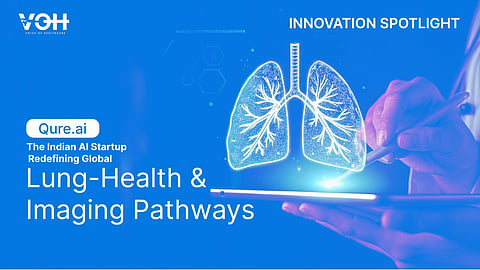

In a world where radiologists are overextended, imaging backlogs continue to grow, and early suspicion of lung cancer remains a global challenge—Qure.ai, founded in Mumbai in 2016, has risen as one of the most influential innovators in medical imaging AI.
With a mission centered on accessibility, affordability and equity, especially in low- and middle-income countries (LMICs), Qure.ai is transforming how chest X-rays and CT scans are interpreted across clinical environments.
Today, its AI solutions support hospitals, screening programs and tele-radiology networks across multiple regions, helping clinicians make faster, more consistent decisions.
Across Asia, Africa and Latin America, millions of chest X-rays are performed annually, yet delays in reporting remain common because of chronic radiologist shortages.
Qure.ai addresses this structural gap through deep-learning algorithms built for real-world constraints, including older X-ray machines and low-bandwidth settings.
Its flagship solution, qXR, detects a wide spectrum of lung abnormalities, including pulmonary nodules—some of which may indicate early suspicion of lung cancer—as well as features associated with tuberculosis, pneumonia and COPD. By elevating the world’s most accessible imaging modality, qXR turns the chest X-ray into a powerful early-triage tool.
Peer-reviewed and conference-level evaluations demonstrate strong performance across diverse populations and imaging environments.
• NIH-supported publication: Deep learning for abnormality detection on chest radiographs
• Malignant nodule identification evidence
Unlike many high-resource AI solutions, Qure.ai applies an equity-first design philosophy, ensuring its models are validated across both advanced centers and resource-limited settings.
Key Innovations
· Deep-learning models trained on large and diverse imaging datasets
· High sensitivity for lung nodules, supported by comparative studies
· Real-time triage, prioritizing abnormal studies
· Seamless integration with PACS, cloud platforms and tele-radiology workflows
By making chest X-ray interpretation more reliable and scalable, Qure.ai supports earlier referrals and reduces missed abnormalities—an especially critical advantage for LMIC public-health systems.
A major accelerator of Qure.ai’s global footprint has been its collaboration with AstraZeneca, within the company’s international A.Catalyst Network. The partnership aligns AI-powered chest X-ray triage with established oncology pathways to improve early suspicion of lung cancer in regions where CT access is limited.
What AstraZeneca Adds Clinically
1. Oncology Pathway Expertise
Ensures that when qXR flags a suspicious nodule, clear referral pathways for follow-up imaging and evaluation are activated.
2. Large-Scale Deployment Across LMICs
The collaboration has enabled more than 5 million AI-enabled chest X-rays, expanding access to early lung-health assessment in underserved regions.
3. High-Impact Real-World Evidence
Company-reported data indicates that these scans have helped identify tens of thousands of potentially high-risk nodules—building one of the world’s largest AI-assisted lung-health datasets in LMIC settings.
qXR – Chest X-Ray AI
Detects lung nodules, TB-suggestive findings, pneumonia, COPD indicators and other incidental abnormalities.
qER – Head CT AI
Identifies intracranial hemorrhage, skull fractures and early stroke markers—supporting rapid decision-making in emergency care.
• FDA Clearance (2024) – qXR-LN Lung Nodule Detection
In 2024, Qure.ai received U.S. FDA 510(k) clearance for qXR-LN, an AI algorithm that identifies and localises lung nodules (6–30 mm) on adult chest radiographs as a second-reader tool.
This milestone places Qure.ai among a limited group of global imaging-AI companies with nodule-specific FDA clearance, validating the algorithm’s accuracy and safety.
• CREATE Study (ELCC 2025) – Multi-Country Lung-Cancer Performance Data
Presented at ELCC 2025, the multi-country CREATE Study evaluated qXR’s lung-nodule model across Egypt, India, Indonesia, Mexico and Turkey.
With a Negative Predictive Value of 93.5%, it demonstrated qXR’s ability to support safe triage and early suspicion pathways in settings with constrained radiology capacity.
Qure.ai’s approach is inherently suited to LMICs and public-health environments:
· Enables opportunistic lung-health screening using routine chest X-rays
· Reduces reporting delays and radiologist burden
· Operates in low-bandwidth, cloud-light environments
· Budget models (e.g., Vietnam) suggest potential cost-neutrality within 3–5 years
· Strengthens triage and early-referral pathways, particularly for lung nodules suspicious for malignancy
By amplifying the diagnostic value of chest X-ray—the most widely available imaging test—Qure.ai supports earlier clinical action in settings where delays are common.
Qure.ai has indicated future plans to extend its AI capabilities toward multi-modality diagnostic models that unify insights across imaging types. While still in development, this direction signals a move from standalone algorithms toward a comprehensive diagnostic intelligence layer.
Qure.ai stands at the cutting edge of global diagnostic innovation—where AI, clinical rigor and health-equity principles intersect.
Through its deep partnership with AstraZeneca, strong real-world evidence, and a growing foundation of regulatory approvals, Qure.ai is reshaping how health systems identify and triage lung disease.
This is innovation where impact meets scale, and where AI becomes a transformative bridge to earlier detection, timely referral and improved outcomes for millions worldwide.